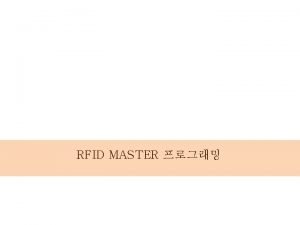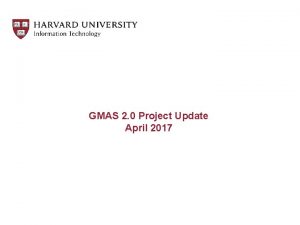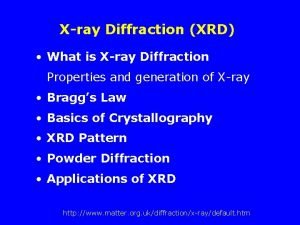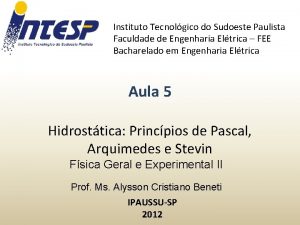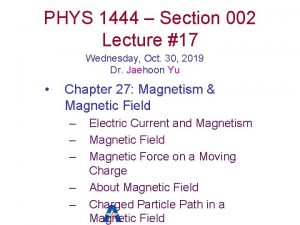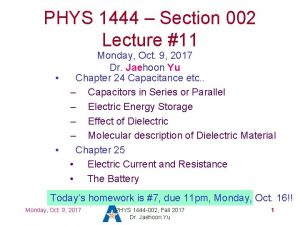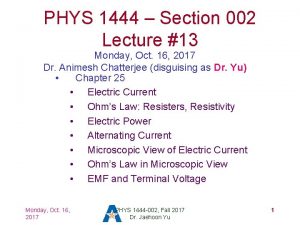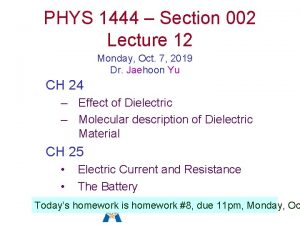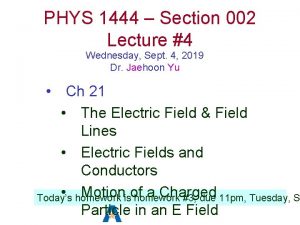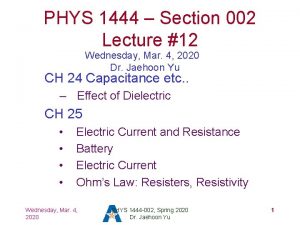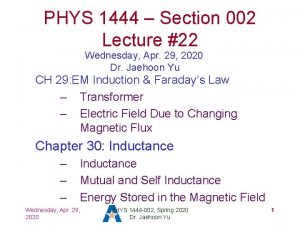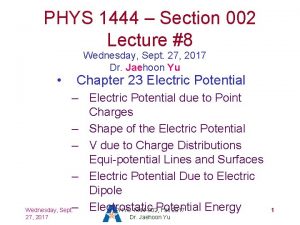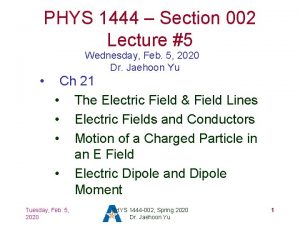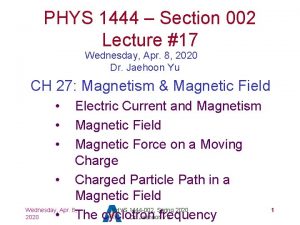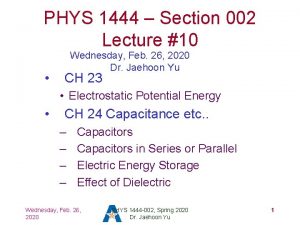PHYS 1444 Section 002 Lecture 10 Wednesday Oct















- Slides: 15

PHYS 1444 – Section 002 Lecture #10 • Wednesday, Oct. 4, 2017 Dr. Jaehoon Yu Chapter 23 Electric Potential – Electrostatic Potential Energy & e. V • Chapter 24 Capacitance etc. . – Capacitors in Series or Parallel – Electric Energy Storage – Effect of Dielectric – Molecular description of Dielectric Wednesday, Oct. 4, PHYS 1444 -002, Fall 2017 1 Material 2017 Dr. Jaehoon Yu

Announcements • Mid Term Exam – In class Wednesday, Oct. 18 – Covers CH 21. 1 through what we cover in class Monday, Oct. 16 + appendix – Bring your calculator but DO NOT input formula into it! • Cell phones or any types of computers cannot replace a calculator! – BYOF: You may bring a one 8. 5 x 11. 5 sheet (front and back) of handwritten formulae and values of constants – No derivations, word definitions or solutions of any kind! – No additional formulae or values of constants will be provided! • Colloquium 4 pm today in SH 100 –Wednesday, Dr. Phil of. PHYS Duke Oct. Barbeau 4, 1444 -002, Fall 2017 Dr. Jaehoon Yu 2


E Determined from V • Potential difference between two points under the electric field is • So in a differential form, we can write – What are d. V and El? • d. V is the infinitesimal potential difference between the two points separated by the distance dl • El is the field component along the direction of dl. • Thus we can write the field component El The component of the electric field as Physical Wednesday, Oct. 4, 2017 in any direction is equal to the Meaning negative rate of change of the ? electric potential as a function of PHYS 1444 -002, Fall 2017 4 Dr. Jaehoon Yu the distance in that direction.

E Determined from V • The quantity d. V/dl is called the gradient of V in a particular direction – If no direction is specified, the term gradient refers to the direction on which V changes most rapidly and this would be the direction of the field vector E at that point. – So if E and dl are parallel to each other, • If V is written as a function of x, y and z, then l refers to x, y and z, and • is the “partial derivative” of V with respect to x, while y and z are held constant is called del or the gradient operator and is a vector operator. 5

Electrostatic Potential Energy • Consider a case in which a point charge q is moved between points a and b where the electrostatic potential due to other charges in the system is Va and Vb • The change in electrostatic potential energy of q in the field by other charges is • Now what is the electrostatic potential energy of a system of charges? – Let’s choose V=0 at r=∞ – If there are no other charges around, single point charge Q 1 in isolation has no potential energy and is under no electric. PHYS force Wednesday, Oct. 4, 1444 -002, Fall 2017 6 2017 Dr. Jaehoon Yu

Electrostatic Potential Energy; Two charges • If the second point charge Q 2 is brought close to Q 1 at a distance r 12, the potential due to Q 1 at the position of Q 2 is • The potential energy of the two charges relative to V=0 at r= ∞ is – This is the work that needs to be done by an external force to bring Q 2 from infinity to the distance r 12 from Q 1. – It is also the negative of the work needed to separate Wednesday, Oct. to 4, infinity. PHYS 1444 -002, Fall 2017 7 them 2017 Dr. Jaehoon Yu

Electrostatic Potential Energy; Three Charges So what do we do for three charges? • • Work is needed to bring all three charges together – Work needed to bring Q 1 to a certain location without the presence of any charge is 0. – Work needed to bring Q 2 to a distance to Q 1 is – Work need to bring Q 3 to certain distances to Q 1 and Q 2 is • So the total electrostatic potential energy of the three charge system is Wednesday, Oct. 4, 2017 PHYS 1444 -002, Fall 2017 Dr. Jaehoon Yu – What about a four charge system or N charge 8

Electrostatic Potential Energy: electron Volt • What is the unit of the electrostatic potential energy? – Joules • Joules is a very large unit in dealing with electrons, atoms or molecules in atomic scale problems • For convenience a new unit, electron volt (e. V), is defined – 1 e. V is defined as the energy acquired by a particle carrying the charge equal to that of an electron (q=e) when it moves across a potential difference of 1 V. – How many Joules is 1 e. V then? • e. V however is NOT a standard SI unit. You must convert the to 1444 -002, Joules for computations. 9 Wednesday, Oct. 4, energy PHYS Fall 2017 Dr. Jaehoon Yu

Capacitors (or Condensers) • What is a capacitor? – A device that can store electric charge – But does not let them flow through • What does it consist of? – Usually consists of two conducting objects (plates or sheets) placed near each other without touching – Why can’t they touch each other? • The charge will neutralize… • Can you give some examples? – Camera flash, UPS, Surge protectors, binary circuits, memory, etc… • How is the capacitor different than the battery? – Battery provides potential difference by storing energy Wednesday, Oct. 4, PHYS 1444 -002, Fall 2017 10 (usually chemical energy) while the capacitor stores 2017 Dr. Jaehoon Yu

Capacitors • A simple capacitor consists of a pair of parallel plates of area A separated by a distance d. – A cylindrical capacitors are essentially parallel plates wrapped around as a cylinder. • How would you draw symbols for a capacitor and a battery? – Capacitor -||– Battery (+) -|i- (-) Wednesday, Oct. 4, 2017 PHYS 1444 -002, Fall 2017 Dr. Jaehoon Yu Circuit Diagram 11

Capacitors • What do you think will happen if a battery is connected ( or the voltage is applied) to a capacitor? – The capacitor gets charged quickly, one plate positive and the other negative in equal amount. • Each battery terminal, the wires and the plates are conductors. What does this mean? – All conductors are at the same potential. And? – So the full battery voltage is applied across the capacitor plates. • So for a given capacitor, the amount of charge stored on each plate is C is capacitor a property of a capacitor so proportional does not depend on to Q or V. the potential difference Vba between the plates. Wednesday, Oct. 4, PHYS 1444 -002, Fall 2017 12 How would you write this formula? C/V Dr. or. Jaehoon Farad (F) Normally use μF or p. F 2017 Yu

Determination of Capacitance • C can be determined analytically for capacitors w/ simple geometry and air in between. • Let’s consider a parallel plate capacitor. – Plates have area A each and separated by d. • d is smaller than the length, and so E is uniform. – E for parallel plates is E=σ/ε 0, σ is the surface charge density. • E and V are related • Since we take the integral from lower potential (a) higher potential (b) along the field line, we obtain • C only depends on the area and the distance of • So from the formula: PHYS 1444 -002, Fall 2017 – What do you notice? Wednesday, Oct. 4, 2017 Dr. Jaehoon Yu the plates and the permittivity of the 13 medium between them.

Example 24 – 1 Capacitor calculations: (a) Calculate the capacitance of a capacitor whose plates are 20 cmx 3. 0 cm and are separated by a 1. 0 mm air gap. (b) What is the charge on each plate if the capacitor is connected to a 12 -V battery? (c) What is the electric field between the plates? (d) Estimate the area of the plates needed to achieve a capacitance of 1 F, given thecapacitor, same air gap. (a) Using the formula for a parallel plate we obtain (b) From Q=CV, the charge on each plate is Wednesday, Oct. 4, 2017 PHYS 1444 -002, Fall 2017 Dr. Jaehoon Yu 14

Example 24 – 1 (C) Using the formula for the electric field in two parallel plates Or, we can since obtain (d) Solving the capacitance formula for A, we obtain Solve for A About 40% the area of Arlington (256 km Wednesday, Oct. 4, 2017 PHYS 1444 -002, Fall 2017 Dr. Jaehoon Yu 15



